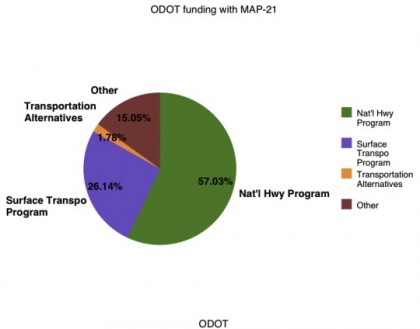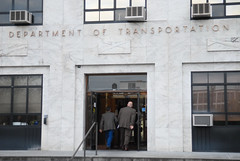Congress officially passed a new, two-year transportation bill today. As I shared yesterday, it’s regarded by active transportation advocates as being downright bad. Even Portland Congressman Earl Blumenauer, who was on the conference committee that hashed out the final bill, calls its passage “strangely anti-climactic” (I spoke with Congressman Blumenauer today and will share his candid take on the bill in a separate story).
For their part, the Oregon Department of Transportation has wasted no time in parsing the numbers to see where their programs and funding levels stand with the new bill. ODOT’s role in doling out federal transportation funds has become heightened because a major theme of the new bill is that it gives more control of the pursestrings to states. For instance, a full one-half of the total amount of money in a new program dubbed “Transportation Alternatives” (about $307 million per year nationwide) will be doled out through a competitive grant program. (States can also decide to spend that chunk on other things, although given ODOT’s track record and trajectory of respect toward active transportation, it’s unlikely they would take part in that sneaky “opt-out” provision.)
Today ODOT released a document (PDF) showing how MAP-21 (the new bill) compares to SAFETEA-LU (the old bill, passed in 2005).
Overall ODOT expects the new bill to equate to a 7% decrease in total federal funding for transportation. Their total funding allotment from the feds in 2011 was $518.7 million and they expect MAP-21 will bring about $483.2 million to the state in 2013. You can see the breakdown of MAP-21 dollars in the chart below (which is split into the various new programs created in the new bill):

(Graphic: BikePortland)
ODOT says they’ll get $132.5 million from the Surface Transportation Program. Of that, Portland will receive $25 million.
In the existing transportation bill, three key programs for funding bicycle-related projects are Transportation Enhancements, Recreational Trails, and Safe Routes to School. Those three programs brought over $16 million to ODOT in 2011. In the new bill, those programs no longer exist on their own. Instead, they’ve been thrown into a soup and are merely considered a type of “eligible project” among many others in a program that will be called “Transportation Alternatives.”
According to ODOT calculations, that entire Transportation Alternatives pot will total just $8.9 million — or a mere 1.8% of the total federal transportation allotment. The way the new law is written, half of that must be dispersed by population (to be distributed by metropolitan planning organizations – ours is Metro), which means Portland will get $1.7 million a year. The other half (about $4.5 million) will be put into a statewide competitive grant program (which Portland will likely win a chunk of).
The Congestion Mitigation and Air Quality (CMAQ) program also took a hit in the new bill. Oregon got about $21 million from that program in 2011, but in 2013 ODOT expects CMAQ funds to total just $18.6 million. The big news for CMAQ is, not only is the total amount lower, but the new bill has added new types of projects into the eligibility pool. For example, Congress has decided that projects that add single-occupancy vehicle lanes and left turn lanes — both of which are not only expensive, but could not have used CMAQ funds at all in the past — can now compete for the money (and it remains unclear how adding lanes on highways does anything to mitigation air quality or congestion, but I digress).
Stay tuned for more coverage of MAP-21 and how it might impact Oregon and Portland.


